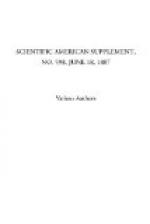[Illustration: FIG. 13.]
[Illustration: FIG. 14.]
The Wheeler & Wilson company do not confine themselves to any particular controller, but prefer the form shown here this evening (Fig. 15), in which two bands and an intermediate pulley are employed. The first band is left rather loose, and the machine is set in motion by the tightening of this band through the depression of the treadle. The speed varies in proportion to the pressure applied, and the sensitiveness of the arrangement is increased by a brake device coming into play by the reversal of the treadle as before.
[Illustration: FIG. 15.]
Messrs. Willcox & Gibbs depend upon a similar device shown in three varieties to-night.
Speed of Power Sewing Machines.—The fastest practicable speed of a machine worked by the foot appears to be 1,000 stitches per minute. Most operators can guide the work at a much higher rate, especially in tailoring or on long seams. The average speed upon such work is 1,200 stitches per minute; but many lock-stitch machines are run at 1,500 and 1,800 per minute, and even at much higher rates. There is always a limit to be imposed upon speed by the guiding powers of hand and eye; it is this limit, and not the capability of the machine, that confines the rate of driving. Willcox & Gibbs’ single thread machines are run in many instances at 3,500 stitches per minute. We have before us a single thread Singer machine (appropriately named the “Lightning Sewer”) and a Willcox machine, moving at the enormous rate of 4,500 stitches per minute, and producing good work. But it is doubtful whether such very great velocities can ever be advantageously employed. Upon collar work, and in sewing boot uppers, the rate seldom rises above 1,200 with advantage. If the machines be speeded too high in any trade, the operator never uses the excess, and it only proves a drawback. I seen the heaviest and hardest kind of navy boots stitched at 1,500 to the minute upon Singer’s lock-stitch machines. Wheeler & Wilson’s No. 10 D machine has been run by them, I am informed, as high as 2,500 to the minute. Loop-stitch machines, when well made, can be actually run as high as 6,000, but 4,500 is, I believe, the maximum yet used for this class of machine, even experimentally. There can be no doubt that lock-stitch machines can be run as high as 3,000. The actual speeds of the lock-stitch machines shown here upon the power stand average 1,300; those of the chain stitch machines vary from 1,200 for the sack sewing machine to 4,500 for the small or single chain stitchers. Any of the latest styles of either lock stitch or single thread machines can be run far faster than any known expert operator can possibly guide the work under it.
It is very improbable that such speeds will ever be exceeded. The limit has no doubt been reached. Very high speed is generally a delusion, and either results in indifferent work, or actually retards its progress. Some idea of the speed of the single thread machines now shown may be gathered from the fact that, running at 4,500, and making eight stitches to the inch, they accomplish over fourteen yards of sewing every minute.




